当前位置:网站首页>Alibaba Sentinel - Slot chain解析
Alibaba Sentinel - Slot chain解析
2022-08-11 08:12:00 【普通人zzz~】
Sentinel - Slot chain
一、插槽链的构建
我们先回顾一下 Alibaba Sentinel - 工作流程及原理解析 中插槽链的构建。
通过 SlotChainBuilder 对象,构建一个插槽链。
public final class SlotChainProvider {
private static volatile SlotChainBuilder slotChainBuilder = null;
// 创建一个新的插槽:通过 SlotChainBuilder 对象构建
public static ProcessorSlotChain newSlotChain() {
if (slotChainBuilder != null) {
return slotChainBuilder.build();
}
// SPI:获取SlotChainBuilder,并加载第一个实例或默认值
slotChainBuilder = SpiLoader.of(SlotChainBuilder.class).loadFirstInstanceOrDefault();
if (slotChainBuilder == null) {
// Should not go through here.
RecordLog.warn("[SlotChainProvider] Wrong state when resolving slot chain builder, using default");
slotChainBuilder = new DefaultSlotChainBuilder();
} else {
RecordLog.info("[SlotChainProvider] Global slot chain builder resolved: {}",
slotChainBuilder.getClass().getCanonicalName());
}
// 构建插槽链
return slotChainBuilder.build();
}
private SlotChainProvider() {
}
}
构建插槽链 slotChainBuilder.build(),代码如下:
@Spi(isDefault = true)
public class DefaultSlotChainBuilder implements SlotChainBuilder {
@Override
public ProcessorSlotChain build() {
// 先创建一个默认的 ProcessorSlotChain
ProcessorSlotChain chain = new DefaultProcessorSlotChain();
// SPI 机制:获取所有 ProcessorSlot(默认的、自定义的),并排序后返回
List<ProcessorSlot> sortedSlotList = SpiLoader.of(ProcessorSlot.class).loadInstanceListSorted();
for (ProcessorSlot slot : sortedSlotList) {
// 去除脏数据
if (!(slot instanceof AbstractLinkedProcessorSlot)) {
RecordLog.warn("The ProcessorSlot(" + slot.getClass().getCanonicalName() + ") is not an instance of AbstractLinkedProcessorSlot, can't be added into ProcessorSlotChain");
continue;
}
chain.addLast((AbstractLinkedProcessorSlot<?>) slot);
}
return chain;
}
}

二、ProcessorSlot
在 Sentinel 里面,所有的资源都对应一个资产名称以及一个 Entry。 Entry 可以通过对主流框架的适配自动创建,也可以通过注解的方式或调用 API 显示创建;每一个 Entry 创建的时候,同时也会创建一系列功能插槽(slot chain),这些插槽有不同的职责,通过责任链方式进行构建,整体框架如下: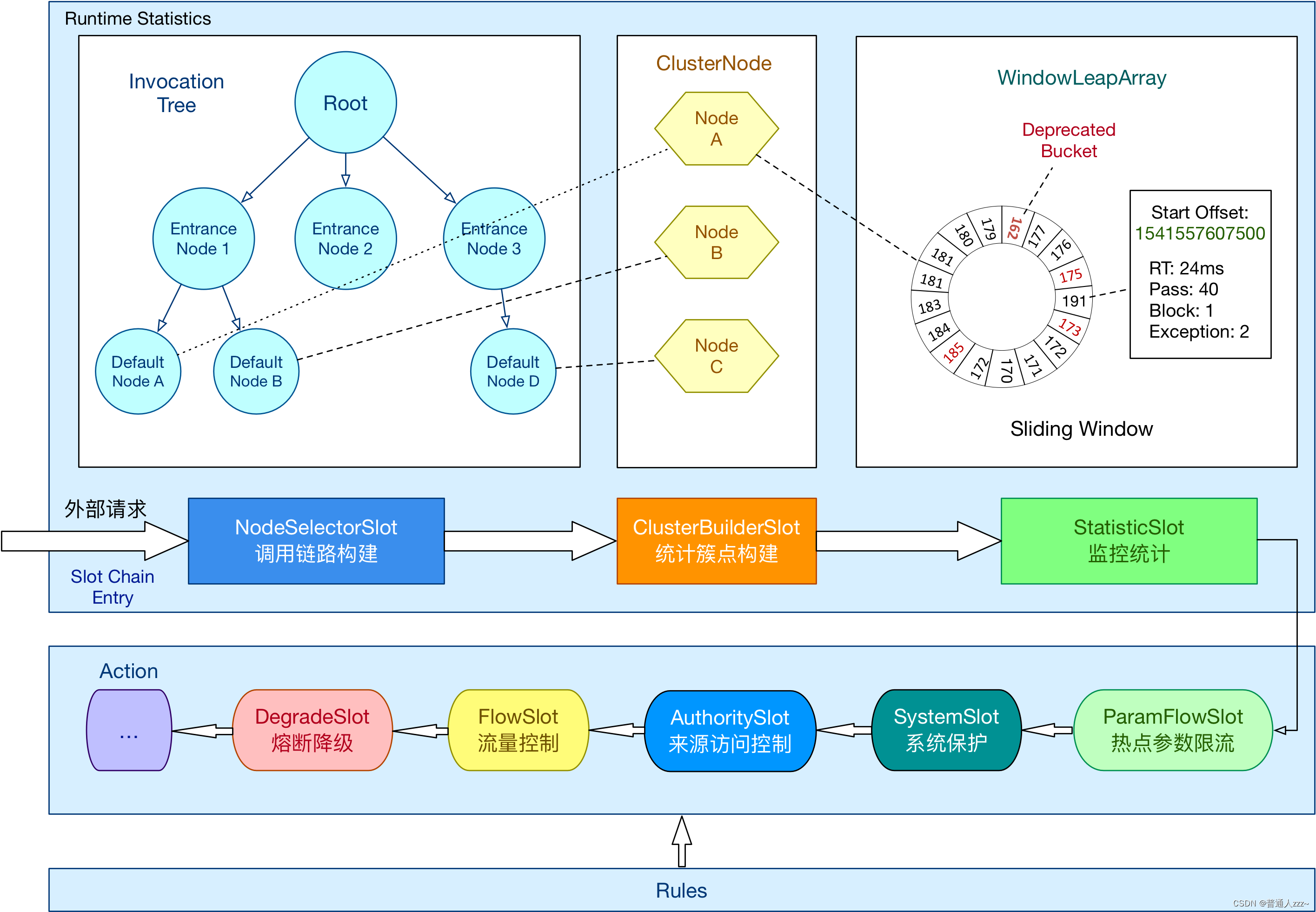
这些插槽(slot chain)具有不同职责。
NodeSelectorSlot:负责收集资源的路径,并将这些资源的调用路径,以树状结构存储起来,用于根据调用路径来限流、降级。ClusterBuilderSlot:用于存储资产的统计信息,以及调用者信息,例如,该资源的RT(平均响应时间)、QPS、Thread Count等等,这些信息将用于作为多维度限流、降级的依据。StatisticsSlot:用于记录、统计不同维度的 runtime 指标监控信息。ParamFlowSlot:用于资源配置热点参数、限流规则以及前面 slot 统计的状态,来进行流量控制。SystemSlot:通过系统的状态,例如 load1 等,来控制总的入口流量。AuthoritySlot:根据配置的黑白名单和调用来源信息,来做黑白名单控制。FlowSlot:用于根据预设的限流规则以及前面 slot 统计的状态,来进行流量控制。DegradeSlot:通过统计信息以及预设的规则,来做熔断降级。
其中 ParamFlowSlot 需要引入另外一个 jar 包,相当于自定义插槽实现的,这里不做过多降级,有兴趣可以参考 Sentinel 官网。
所有的插槽都继承自 AbstractLinkedProcessorSlot 抽象类(顶层为 ProcessorSlot 实现)。
public interface ProcessorSlot<T> {
// 执行
void entry(Context context, ResourceWrapper resourceWrapper, T param, int count, boolean prioritized,
Object... args) throws Throwable;
// 链路调用entry
void fireEntry(Context context, ResourceWrapper resourceWrapper, Object obj, int count, boolean prioritized,
Object... args) throws Throwable;
// 退出当前slot
void exit(Context context, ResourceWrapper resourceWrapper, int count, Object... args);
// 链路调用exit
void fireExit(Context context, ResourceWrapper resourceWrapper, int count, Object... args);
}
当然,我们也可以自定义插槽。
Sentinel 将 com.alibaba.csp.sentinel.slotchain.ProcessorSlot 作为 SPI 接口进行扩展(1.7.2 版本以前 com.alibaba.csp.sentinel.slotchain.SlotChainBuilder 作为 SPI),使得 Slot Chain 具备了扩展的能力。
您可以自行加入自定义的 slot 并编排 slot 间的顺序,从而可以给 Sentinel 添加自定义的功能。

默认处理器插槽的顺序
// NodeSelectorSlot
public static final int ORDER_NODE_SELECTOR_SLOT = -10000;
// ClusterBuilderSlot
public static final int ORDER_CLUSTER_BUILDER_SLOT = -9000;
// LogSlot
public static final int ORDER_LOG_SLOT = -8000;
// StatisticsSlot
public static final int ORDER_STATISTIC_SLOT = -7000;
// AuthoritySlot
public static final int ORDER_AUTHORITY_SLOT = -6000;
// SystemSlot
public static final int ORDER_SYSTEM_SLOT = -5000;
// FlowSlot
public static final int ORDER_FLOW_SLOT = -2000;
// DegradeSlot
public static final int ORDER_DEGRADE_SLOT = -1000;
下面我会根据整个插槽链的处理顺序进行源码分析。
1. NodeSelectorSlot
负责收集资源的路径,并将这些资源的调用路径,以树状结构存储起来,用于根据调用路径来限流、降级。
例如:
ContextUtil.enter("entrance1", "appA");
Entry nodeA = SphU.entry("nodeA");
if (nodeA != null) {
nodeA.exit();
}
ContextUtil.exit();
ContextUtil.enter("entrance2", "appA");
nodeA = SphU.entry("nodeA");
if (nodeA != null) {
nodeA.exit();
}
ContextUtil.exit();
// 上面的代码会在内存中生成如下调用结构:
/** * * machine-root * / \ * / \ * EntranceNode1 EntranceNode2 * / \ * / \ * DefaultNode(nodeA) DefaultNode(nodeA) * | | * +- - - - - - - - - - +- - - - - - -> ClusterNode(nodeA); */
注意:可以通过调用 http:localhost:8719tree?type=root 来检查这个结构
核心代码:
@Spi(isSingleton = false, order = Constants.ORDER_NODE_SELECTOR_SLOT)
public class NodeSelectorSlot extends AbstractLinkedProcessorSlot<Object> {
// 存储当前资源所有调用Node
// key -> 上下文name value -> 节点node
private volatile Map<String, DefaultNode> map = new HashMap<String, DefaultNode>(10);
@Override
public void entry(Context context, ResourceWrapper resourceWrapper, Object obj, int count, boolean prioritized, Object... args)
throws Throwable {
// 根据 context name 获取Node
DefaultNode node = map.get(context.getName());
if (node == null) {
synchronized (this) {
node = map.get(context.getName());
// 不存在,创建一个Node
if (node == null) {
node = new DefaultNode(resourceWrapper, null);
HashMap<String, DefaultNode> cacheMap = new HashMap<String, DefaultNode>(map.size());
cacheMap.putAll(map);
cacheMap.put(context.getName(), node);
map = cacheMap;
// Build invocation tree
// 构建调用树
((DefaultNode) context.getLastNode()).addChild(node);
}
}
}
// 设置当前节点
context.setCurNode(node);
// 调用下一个链路
fireEntry(context, resourceWrapper, node, count, prioritized, args);
}
@Override
public void exit(Context context, ResourceWrapper resourceWrapper, int count, Object... args) {
// 退出
fireExit(context, resourceWrapper, count, args);
}
}
2. ClusterBuilderSlot
用于存储资源的统计信息,以及调用者信息,例如,该资源的RT、QPS、Thread count等,这些信息将用于作为多维度限流、降级的依据。
@Spi(isSingleton = false, order = Constants.ORDER_CLUSTER_BUILDER_SLOT)
public class ClusterBuilderSlot extends AbstractLinkedProcessorSlot<DefaultNode> {
// 集群节点信息
// key -> 资源 value -> 集群节点
private static volatile Map<ResourceWrapper, ClusterNode> clusterNodeMap = new HashMap<>();
private static final Object lock = new Object();
private volatile ClusterNode clusterNode = null;
@Override
public void entry(Context context, ResourceWrapper resourceWrapper, DefaultNode node, int count,
boolean prioritized, Object... args)
throws Throwable {
if (clusterNode == null) {
synchronized (lock) {
if (clusterNode == null) {
// Create the cluster node.
// 创建集群节点
clusterNode = new ClusterNode(resourceWrapper.getName(), resourceWrapper.getResourceType());
HashMap<ResourceWrapper, ClusterNode> newMap = new HashMap<>(Math.max(clusterNodeMap.size(), 16));
newMap.putAll(clusterNodeMap);
newMap.put(node.getId(), clusterNode);
clusterNodeMap = newMap;
}
}
}
// 给当前Node 设置 ClusterNode 信息
node.setClusterNode(clusterNode);
// 如果设置了上下文来源origin,我们应该获取或创建 OriginNode
if (!"".equals(context.getOrigin())) {
Node originNode = node.getClusterNode().getOrCreateOriginNode(context.getOrigin());
context.getCurEntry().setOriginNode(originNode);
}
// 调用下一个链路
fireEntry(context, resourceWrapper, node, count, prioritized, args);
}
@Override
public void exit(Context context, ResourceWrapper resourceWrapper, int count, Object... args) {
// 退出
fireExit(context, resourceWrapper, count, args);
}
// 根据资源id、节点类型获取 ClusterNode
public static ClusterNode getClusterNode(String id, EntryType type) {
return clusterNodeMap.get(new StringResourceWrapper(id, type));
}
// 根据资源id获取 ClusterNode
public static ClusterNode getClusterNode(String id) {
if (id == null) {
return null;
}
ClusterNode clusterNode = null;
for (EntryType nodeType : EntryType.values()) {
clusterNode = clusterNodeMap.get(new StringResourceWrapper(id, nodeType));
if (clusterNode != null) {
break;
}
}
return clusterNode;
}
public static Map<ResourceWrapper, ClusterNode> getClusterNodeMap() {
return clusterNodeMap;
}
// 重置
public static void resetClusterNodes() {
for (ClusterNode node : clusterNodeMap.values()) {
node.reset();
}
}
}
3. LogSlot
用于日志监控。
4. StatisticsSlot
用于记录、统计不同维度的 runtime 指标监控信息。
@Spi(order = Constants.ORDER_STATISTIC_SLOT)
public class StatisticSlot extends AbstractLinkedProcessorSlot<DefaultNode> {
@Override
public void entry(Context context, ResourceWrapper resourceWrapper, DefaultNode node, int count,
boolean prioritized, Object... args) throws Throwable {
try {
// Do some checking.
// 执行后续链路的entry方法,顺序是 AuthoritySlot -> SystemSlot -> FlowSlot -> DegradeSlot,做一些白名单、系统状态、规则限流、熔断检查
fireEntry(context, resourceWrapper, node, count, prioritized, args);
// 请求通过,添加线程数
// Request passed, add thread count and pass count.
node.increaseThreadNum();
// 请求通过,添加请求通过数
node.addPassRequest(count);
if (context.getCurEntry().getOriginNode() != null) {
// 添加 OrginNode 统计计数
// Add count for origin node.
context.getCurEntry().getOriginNode().increaseThreadNum();
context.getCurEntry().getOriginNode().addPassRequest(count);
}
if (resourceWrapper.getEntryType() == EntryType.IN) {
// 如果请求类型为IN,添加全局统计计数
// Add count for global inbound entry node for global statistics.
Constants.ENTRY_NODE.increaseThreadNum();
Constants.ENTRY_NODE.addPassRequest(count);
}
// 执行onPass CallBack
// Handle pass event with registered entry callback handlers.
for (ProcessorSlotEntryCallback<DefaultNode> handler : StatisticSlotCallbackRegistry.getEntryCallbacks()) {
handler.onPass(context, resourceWrapper, node, count, args);
}
} catch (PriorityWaitException ex) {
// PriorityWaitException 异常处理,添加线程数
node.increaseThreadNum();
if (context.getCurEntry().getOriginNode() != null) {
// Add count for origin node.
context.getCurEntry().getOriginNode().increaseThreadNum();
}
if (resourceWrapper.getEntryType() == EntryType.IN) {
// Add count for global inbound entry node for global statistics.
Constants.ENTRY_NODE.increaseThreadNum();
}
// Handle pass event with registered entry callback handlers.
for (ProcessorSlotEntryCallback<DefaultNode> handler : StatisticSlotCallbackRegistry.getEntryCallbacks()) {
handler.onPass(context, resourceWrapper, node, count, args);
}
} catch (BlockException e) {
// BlockException 异常处理,添加阻塞Qps
// Blocked, set block exception to current entry.
context.getCurEntry().setBlockError(e);
// Add block count.
node.increaseBlockQps(count);
if (context.getCurEntry().getOriginNode() != null) {
context.getCurEntry().getOriginNode().increaseBlockQps(count);
}
if (resourceWrapper.getEntryType() == EntryType.IN) {
// Add count for global inbound entry node for global statistics.
Constants.ENTRY_NODE.increaseBlockQps(count);
}
// 执行onBlocked CallBack
// Handle block event with registered entry callback handlers.
for (ProcessorSlotEntryCallback<DefaultNode> handler : StatisticSlotCallbackRegistry.getEntryCallbacks()) {
handler.onBlocked(e, context, resourceWrapper, node, count, args);
}
throw e;
} catch (Throwable e) {
// 其他异常
// Unexpected internal error, set error to current entry.
context.getCurEntry().setError(e);
throw e;
}
}
@Override
public void exit(Context context, ResourceWrapper resourceWrapper, int count, Object... args) {
// 退出
Node node = context.getCurNode();
if (context.getCurEntry().getBlockError() == null) {
// Calculate response time (use completeStatTime as the time of completion).
long completeStatTime = TimeUtil.currentTimeMillis();
context.getCurEntry().setCompleteTimestamp(completeStatTime);
long rt = completeStatTime - context.getCurEntry().getCreateTimestamp();
Throwable error = context.getCurEntry().getError();
// Record response time and success count.
recordCompleteFor(node, count, rt, error);
recordCompleteFor(context.getCurEntry().getOriginNode(), count, rt, error);
if (resourceWrapper.getEntryType() == EntryType.IN) {
recordCompleteFor(Constants.ENTRY_NODE, count, rt, error);
}
}
// Handle exit event with registered exit callback handlers.
Collection<ProcessorSlotExitCallback> exitCallbacks = StatisticSlotCallbackRegistry.getExitCallbacks();
for (ProcessorSlotExitCallback handler : exitCallbacks) {
handler.onExit(context, resourceWrapper, count, args);
}
// fix bug https://github.com/alibaba/Sentinel/issues/2374
fireExit(context, resourceWrapper, count, args);
}
private void recordCompleteFor(Node node, int batchCount, long rt, Throwable error) {
if (node == null) {
return;
}
node.addRtAndSuccess(rt, batchCount);
node.decreaseThreadNum();
if (error != null && !(error instanceof BlockException)) {
node.increaseExceptionQps(batchCount);
}
}
}
5. AuthoritySlot
根据配置的黑白名单和调用来源信息,来做黑白名单控制。
@Spi(order = Constants.ORDER_AUTHORITY_SLOT)
public class AuthoritySlot extends AbstractLinkedProcessorSlot<DefaultNode> {
@Override
public void entry(Context context, ResourceWrapper resourceWrapper, DefaultNode node, int count, boolean prioritized, Object... args)
throws Throwable {
// 黑白名单检查
checkBlackWhiteAuthority(resourceWrapper, context);
// 调用下一个链路
fireEntry(context, resourceWrapper, node, count, prioritized, args);
}
@Override
public void exit(Context context, ResourceWrapper resourceWrapper, int count, Object... args) {
// 退出
fireExit(context, resourceWrapper, count, args);
}
// 黑白名单检查
void checkBlackWhiteAuthority(ResourceWrapper resource, Context context) throws AuthorityException {
// 获取所有 AuthorityRule
Map<String, Set<AuthorityRule>> authorityRules = AuthorityRuleManager.getAuthorityRules();
if (authorityRules == null) {
return;
}
// 获取当前 Resource 的所有AuthorityRule
Set<AuthorityRule> rules = authorityRules.get(resource.getName());
if (rules == null) {
return;
}
// 黑白名单检查
for (AuthorityRule rule : rules) {
if (!AuthorityRuleChecker.passCheck(rule, context)) {
throw new AuthorityException(context.getOrigin(), rule);
}
}
}
}
6. SystemSlot
通过系统的状态,例如load1 等,来控制总的入口流量。
@Spi(order = Constants.ORDER_SYSTEM_SLOT)
public class SystemSlot extends AbstractLinkedProcessorSlot<DefaultNode> {
@Override
public void entry(Context context, ResourceWrapper resourceWrapper, DefaultNode node, int count,
boolean prioritized, Object... args) throws Throwable {
// 系统检查
SystemRuleManager.checkSystem(resourceWrapper, count);
// 调用下一个链路
fireEntry(context, resourceWrapper, node, count, prioritized, args);
}
@Override
public void exit(Context context, ResourceWrapper resourceWrapper, int count, Object... args) {
// 退出
fireExit(context, resourceWrapper, count, args);
}
}
SystemRuleManager.checkSystem(resourceWrapper, count); 方法如下:
public final class SystemRuleManager {
public static void checkSystem(ResourceWrapper resourceWrapper, int count) throws BlockException {
if (resourceWrapper == null) {
return;
}
// 确保检查开关已打开。
if (!checkSystemStatus.get()) {
return;
}
// 只检查入口流量
if (resourceWrapper.getEntryType() != EntryType.IN) {
return;
}
// 统计 qps
double currentQps = Constants.ENTRY_NODE == null ? 0.0 : Constants.ENTRY_NODE.passQps();
if (currentQps + count > qps) {
throw new SystemBlockException(resourceWrapper.getName(), "qps");
}
// 统计 线程数
int currentThread = Constants.ENTRY_NODE == null ? 0 : Constants.ENTRY_NODE.curThreadNum();
if (currentThread > maxThread) {
throw new SystemBlockException(resourceWrapper.getName(), "thread");
}
// 统计 平均响应时间
double rt = Constants.ENTRY_NODE == null ? 0 : Constants.ENTRY_NODE.avgRt();
if (rt > maxRt) {
throw new SystemBlockException(resourceWrapper.getName(), "rt");
}
// load. BBR algorithm.
if (highestSystemLoadIsSet && getCurrentSystemAvgLoad() > highestSystemLoad) {
if (!checkBbr(currentThread)) {
throw new SystemBlockException(resourceWrapper.getName(), "load");
}
}
// cpu usage
if (highestCpuUsageIsSet && getCurrentCpuUsage() > highestCpuUsage) {
throw new SystemBlockException(resourceWrapper.getName(), "cpu");
}
}
}
7. FlowSlot
用于根据预设的限流规则已经前面的 slot 统计的状态,来进行流量控制。
@Spi(order = Constants.ORDER_FLOW_SLOT)
public class FlowSlot extends AbstractLinkedProcessorSlot<DefaultNode> {
private final FlowRuleChecker checker;
public FlowSlot() {
this(new FlowRuleChecker());
}
FlowSlot(FlowRuleChecker checker) {
AssertUtil.notNull(checker, "flow checker should not be null");
this.checker = checker;
}
@Override
public void entry(Context context, ResourceWrapper resourceWrapper, DefaultNode node, int count,
boolean prioritized, Object... args) throws Throwable {
// 规则检查
checkFlow(resourceWrapper, context, node, count, prioritized);
// 调用下一个链路
fireEntry(context, resourceWrapper, node, count, prioritized, args);
}
// 规则检查
void checkFlow(ResourceWrapper resource, Context context, DefaultNode node, int count, boolean prioritized)
throws BlockException {
checker.checkFlow(ruleProvider, resource, context, node, count, prioritized);
}
@Override
public void exit(Context context, ResourceWrapper resourceWrapper, int count, Object... args) {
// 退出
fireExit(context, resourceWrapper, count, args);
}
// 获取当前 Resource 所有 FlowRule
private final Function<String, Collection<FlowRule>> ruleProvider = new Function<String, Collection<FlowRule>>() {
@Override
public Collection<FlowRule> apply(String resource) {
// Flow rule map should not be null.
Map<String, List<FlowRule>> flowRules = FlowRuleManager.getFlowRuleMap();
return flowRules.get(resource);
}
};
}
8. DegradeSlot
通过统计信息以及预设的规则,来做熔断降级。
@Spi(order = Constants.ORDER_DEGRADE_SLOT)
public class DegradeSlot extends AbstractLinkedProcessorSlot<DefaultNode> {
@Override
public void entry(Context context, ResourceWrapper resourceWrapper, DefaultNode node, int count,
boolean prioritized, Object... args) throws Throwable {
// 检查
performChecking(context, resourceWrapper);
// 调用下一个链路
fireEntry(context, resourceWrapper, node, count, prioritized, args);
}
// 检查
void performChecking(Context context, ResourceWrapper r) throws BlockException {
// 获取当前 Resource 所有 CircuitBreaker
List<CircuitBreaker> circuitBreakers = DegradeRuleManager.getCircuitBreakers(r.getName());
if (circuitBreakers == null || circuitBreakers.isEmpty()) {
return;
}
for (CircuitBreaker cb : circuitBreakers) {
// 尝试通过
if (!cb.tryPass(context)) {
// 抛出降级异常DegradeException
throw new DegradeException(cb.getRule().getLimitApp(), cb.getRule());
}
}
}
@Override
public void exit(Context context, ResourceWrapper r, int count, Object... args) {
Entry curEntry = context.getCurEntry();
if (curEntry.getBlockError() != null) {
fireExit(context, r, count, args);
return;
}
List<CircuitBreaker> circuitBreakers = DegradeRuleManager.getCircuitBreakers(r.getName());
if (circuitBreakers == null || circuitBreakers.isEmpty()) {
fireExit(context, r, count, args);
return;
}
if (curEntry.getBlockError() == null) {
// passed request
for (CircuitBreaker circuitBreaker : circuitBreakers) {
circuitBreaker.onRequestComplete(context);
}
}
fireExit(context, r, count, args);
}
}
DegradeException 异常类 类结构图如下,会在 StatisticsSlot 中被捕获处理,代码如下: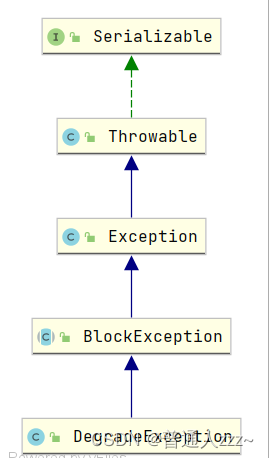
@Spi(order = Constants.ORDER_STATISTIC_SLOT)
public class StatisticSlot extends AbstractLinkedProcessorSlot<DefaultNode> {
@Override
public void entry(Context context, ResourceWrapper resourceWrapper, DefaultNode node, int count,
boolean prioritized, Object... args) throws Throwable {
try {
......
} catch (PriorityWaitException ex) {
// PriorityWaitException 异常处理,添加线程数
......
} catch (BlockException e) {
// BlockException 异常处理,添加阻塞Qps
// Blocked, set block exception to current entry.
context.getCurEntry().setBlockError(e);
// Add block count.
node.increaseBlockQps(count);
if (context.getCurEntry().getOriginNode() != null) {
context.getCurEntry().getOriginNode().increaseBlockQps(count);
}
if (resourceWrapper.getEntryType() == EntryType.IN) {
// Add count for global inbound entry node for global statistics.
Constants.ENTRY_NODE.increaseBlockQps(count);
}
// 执行onBlocked CallBack:降级
// Handle block event with registered entry callback handlers.
for (ProcessorSlotEntryCallback<DefaultNode> handler : StatisticSlotCallbackRegistry.getEntryCallbacks()) {
handler.onBlocked(e, context, resourceWrapper, node, count, args);
}
throw e;
} catch (Throwable e) {
// 其他异常
// Unexpected internal error, set error to current entry.
context.getCurEntry().setError(e);
throw e;
}
}
}
经过上面的分析,Sentinel通过各个 Slot 完成统计、限流、降级等逻辑,但Sentinel 是如何进行流量统计(线程数、RT、QPS等)的核心代码还未分析到,实际上,Sentinel 是通过滑动窗口完成上面各个维度的统计的。
三、Sentinel 滑动窗口
边栏推荐
猜你喜欢
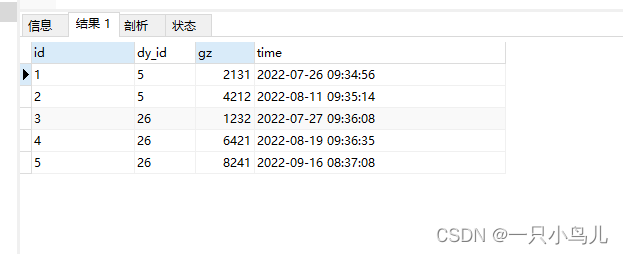
查找最新人员工资和上上次人员工资的变动情况
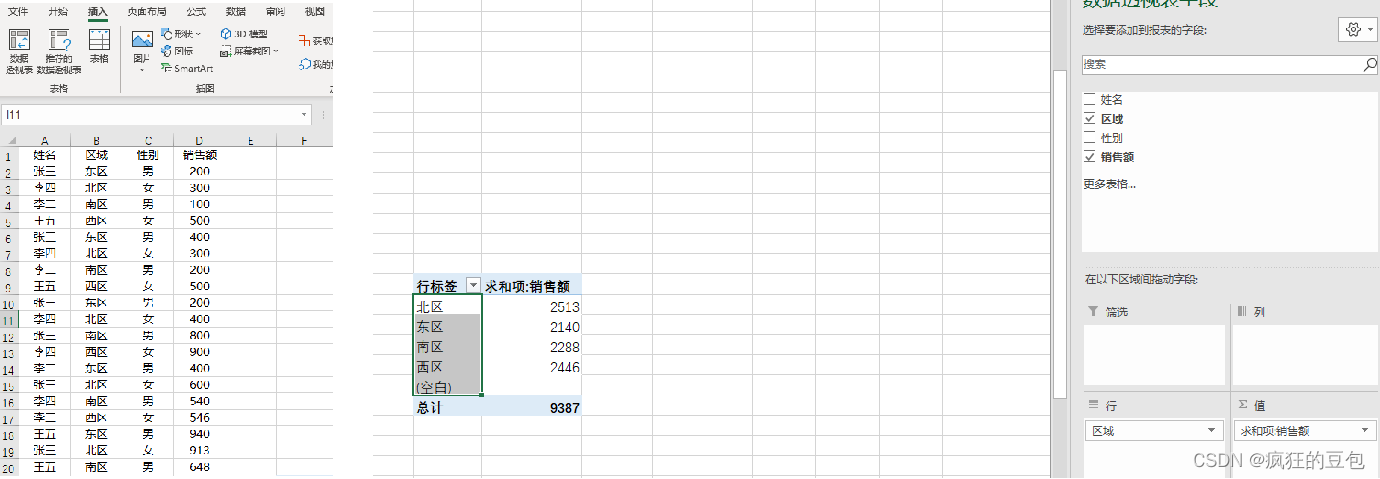
The most complete documentation on Excel's implementation of grouped summation
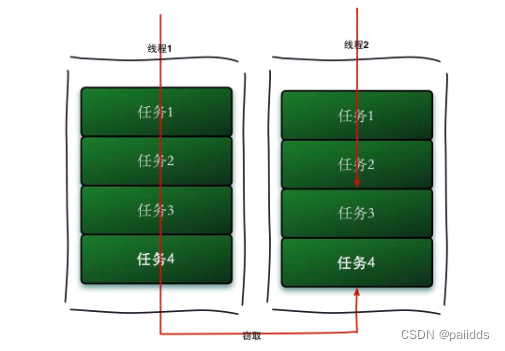
JUC并发编程
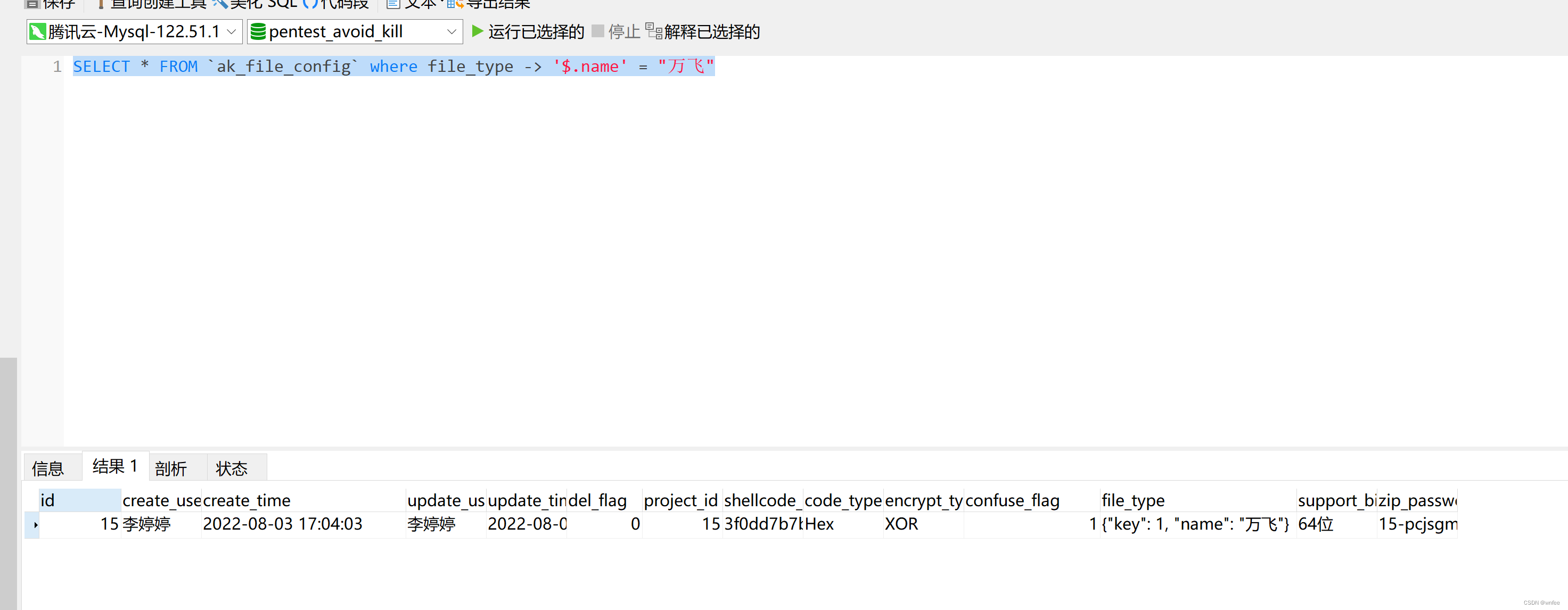
Mysql JSON对象和JSON数组查询
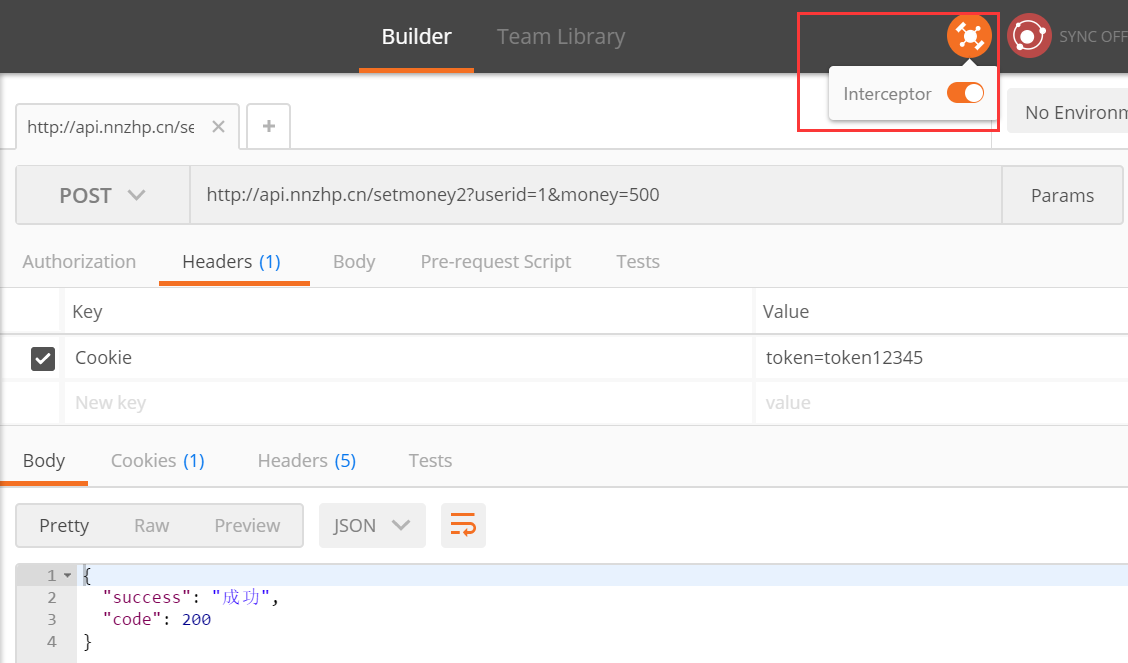
Do you know the basic process and use case design method of interface testing?

关于#sql#的问题:怎么将下面的数据按逗号分隔成多行,以列的形式展示出来

Hibernate 的 Session 缓存相关操作
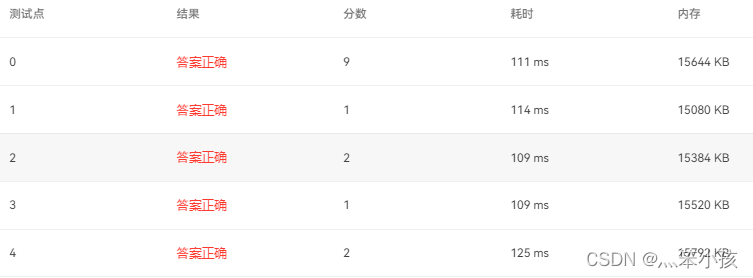
1046 punches (15 points)

1081 Check Password (15 points)

囍楽cloud task source code
随机推荐
兼容并蓄广纳百川,Go lang1.18入门精炼教程,由白丁入鸿儒,go lang复合容器类型的声明和使用EP04
【LeetCode】链表题解汇总
golang 字符串操作
4.1 - Support Vector Machines
AcWing 272. 最长公共上升子序列
零基础SQL教程: 主键、外键和索引 04
Keep track of your monthly income and expenses through bookkeeping
kali渗透测试环境搭建
Decrement operation in tf; tf.assign_sub()
Square, multi-power, square root calculation in Tf
Pico neo3 Unity Packaging Settings
小目标检测3_注意力机制_Self-Attention
matrix multiplication in tf
支持各种文件快速重命名最简单的小技巧
分布式锁-Redission - 缓存一致性解决
几何EX3 功夫牛宣布停售,入门级纯电产品为何总成弃子
老干妈创始人陶华碧现身直播间,70岁“国民女神”拥抱直播电商
matplotlib
JRS303-Data Verification
The most complete documentation on Excel's implementation of grouped summation